Japan Foundation Prizes for Global Citizenship Public Roundtable Report 【Part 1】
Fostering Communication Through Art: Case Studies in Global Citizenship Activities
2025.3.13
【Special Feature 085】
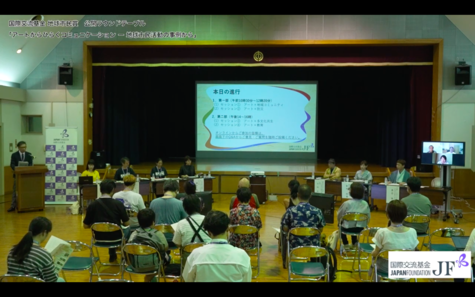
The Japan Foundation Prizes for Global Citizenship are awarded to organizations that make a lasting impact through international cultural exchange in their local community. In June 2024, a public roundtable took place in Okinawa, showcasing the power of art to connect diverse social areas. At the event were representatives from six past award-winning organizations, a moderator, and commentators who engaged in four sessions of sixty minutes each; other participants were welcomed in person or online. The sessions explored the role of art in four domains: local communities, disaster prevention and preparedness, multicultural coexistence, and education. Each organization shared an overview of their projects and discussed their impact, exchanging ideas with each other in an engaging and dynamic forum. This report captures the key moments of these discussions--Part 1 covers Sessions 1 & 2; Part 2, Sessions 3 & 4. Discover the highlights here and learn even more by viewing the sessions in their entirety on YouTube (link below)!
Date: Sunday, June 30, 2024
Venue: Wakasa Community Center, 3rd Floor Hall, Naha City, Okinawa
Part 1
Session 1: Art × Local Communities
Session 2: Art × Disaster Prevention
Part 2
Session 3: Art × Multicultural Coexistence
Session 4: Art × Education
////////////////////////////////////////////////////////////////////////////////////////
Presenters(Honorifics omitted; award type and year in square brackets)
Session Key[LC]Local Communities [DP]Disaster Prevention [MC]Multicultural Coexistence [ED]Education
▶︎Speakers:
Jun Miyagi (Executive Director, Chiiki Support Wakasa) Okinawa [2022] [LC][DP][ED]
Junko Sato (Staff, Chiiki Support Wakasa) Okinawa [2022] [MC]
Yuka Aoki (Chair, Alece Takaoka) Toyama [2022] [DP][MC][ED]
Hisashi Shimoyama (Representative, The International Theater Festival Okinawa for Young Audiences Executive Committee) Okinawa [2019] [MC][ED]
Hirokazu Nagata (Executive Director, Plus Arts) Hyogo [2014] [LC][DP]
Shizuka Morishita (Director, Tanpopo-no-Ye / Center Director, Good Job! Center KASHIBA) Nara [1994][LC][MC]
Rika Uechi (Chief Program Officer, Okinawa Arts Council) Okinawa [LC][DP]
Yukihiro Gushi (Program Officer, Okinawa Arts Council) Okinawa[MC][ED]
Noriko Shimabukuro (Chair, AmerAsian School in Okinawa) Okinawa [2014][ED]欠席
▶︎Moderator:Tomoko Wakabayashi (Project Coordinator / Specially Appointed Professor, Rikkyo University Graduate School of Social Design Studies)
▶︎Commentator:Taro Tamura (Representative Director, Institute for Human Diversity Japan)
More details of the speakers' profiles here⟩⟩⟩
////////////////////////////////////////////////////////////////////////////////////////
Session 1 *Full-session video available here⟩⟩⟩
Art × Local Communities
//////////////////////////////////////////////////
Jun Miyagi (Chiiki Support Wakasa) [LC][DP][ED]
Hirokazu Nagata (Plus Arts) [LC][DP]
Shizuka Morishita (Tanpopo-no-Ye)[LC][MC]
Rika Uechi (Okinawa Arts Council) [LC][DP]
++++++++++++++++++++++++++++++++++++++++++++++++++++++++
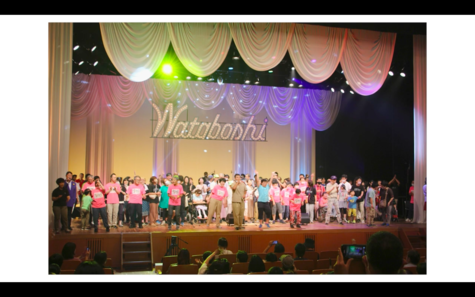
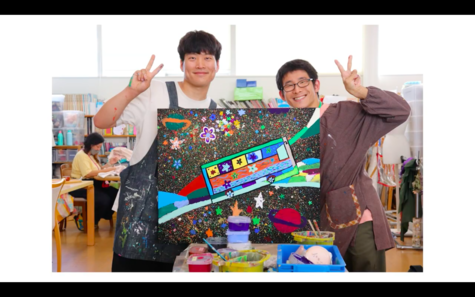
Activity Report①
Tanpopo-no-Ye (Nara Prefecture) Shizuka Morishita, Director
Tanpopo-no-Ye has been a trailblazer in promoting diversity--through powerful initiatives like the Wataboshi concerts, which will celebrate their fiftieth anniversary in 2025, and the Asia-Pacific Wataboshi Music Festival, an ongoing celebration since the 1990s. The organization's mission is to empower people with disabilities by providing opportunities for groundbreaking jobs and connecting diverse industries in creative ways.
★ In this session, we dive into the vibrant work of the Good Job! Center KASHIBA, revealing how they transform lives and make a lasting impact.
Designing Society Together with People with Disabilities
At Good Job! Center KASHIBA, creativity, work, and expression merge dynamically to create new job opportunities that involve communication through art and collaboration across industries. One of their standout initiatives, NEW TRADITIONAL, brings together traditional crafts and wellness in projects like Hammering and Sawing Woodwork and the Silkworm Project, which blend the old and the new and reach out to global audiences. Their initiative Art for Well-Being commingles self-expression, care, and technology in an exploration of artistic expression--using activities such as MR (mixed reality), dance, AI-powered music, and the sale of NFT (non-fungible tokens) art to push the boundaries of digital and real-world creativity and connect online and offline communities.
++++++++++++++++++++++++++++++++++++++++++++++++++++++++
【Roundtable Discussion】
Wakabayashi:As pioneers in blending art and welfare, you're leading truly groundbreaking initiatives. When connecting with local communities, what key elements of communication do you focus on?
Morishita: I really believe it's important to not only focus on the mainstream but also explore the fringes. When people think of art, they tend to picture museums or theater performances--which is fine--but bringing art into everyday life is also truly special. For instance, in our Private Museum project, we invited shop owners in Nara's shopping district to select and display artworks created by local people with disabilities. This kind of simple act sparks conversations with customers and makes art a natural part of daily life. We have also ventured into the digital realm of NFT art, where every piece is uniquely verified. Although such digital expression may be new to some, many young people are embracing it. By building communities both online and offline, we're fostering connections that make everyday life richer and more meaningful.
Wakabayashi:It's amazing how communication has become so multi-dimensional, isn't it?
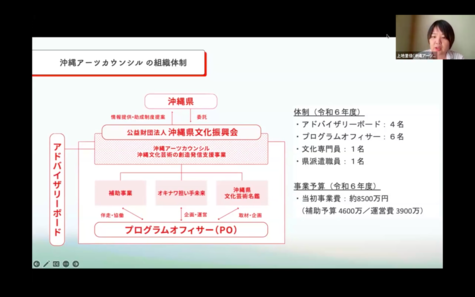
Uechi:I'm truly impressed that you embrace change and unlock new possibilities in this way. At the Okinawa Arts Council, our goal is to promote the sustainable growth of Okinawa's diverse traditional arts and cultural activities. We've been supporting local initiatives through grants, leadership development, and the creation of a cultural-arts database. Since 2023, we have supported the UNIVA Association on Ishigaki Island, which collaborates with people with disabilities on theater projects. In such transformative initiatives, how do you build a shared understanding among the support team and staff? Do you develop a common framework or a shared language within your organization and the community?
Morishita:We can't simply say there's no distinction between people with disabilities and those without disabilities. When it comes to public support, we often have to draw boundaries within the system in order to offer help. But the essential nature of welfare demands the creation of a culture of mutual aid within the community--for children, women, older adults, and people with disabilities. It's not about whether someone is a user or a supporter, but about building a culture where people genuinely want to stay involved and work together. I believe that art and cultural activities can help make this invisible side of welfare visible, sharing it in a way that connects and inspires the community.
Tamura:After the 1995 Great Hanshin Earthquake, we established the Center for Multicultural Information and Assistance (formerly the Foreigners' Earthquake Information Center) to support foreign disaster victims, for which we received the Prize for Global Citizenship. Now, thirty years later, the world has changed in so many ways. Just as the expression of art has evolved, our understanding of disability has also expanded. Whereas we once viewed it through a purely physical lens, we now recognize neurodiversity, embracing a broad range of mental and developmental conditions. The boundaries between people with disabilities and those without are becoming increasingly blurred, with diversity becoming a key focus. Both Tanpopo-no-Ye and the Okinawa Arts Council are evolving alongside these societal shifts. I found Ms. Morishita's point about exploring the fringes particularly powerful. When we step outside the conventional world view, we begin to see things that we never noticed before. When I visit a place where people with disabilities work, I often wonder: Do we enjoy working as much as they do? It's a powerful reminder that we need to rethink our lifestyle and treat work as play.
Nagata: I had the opportunity to invite Ms. Morishita as a guest speaker at a study session at KIITO, where I'm the center director, and I was really impressed by how effortlessly she connects different ideas and elements. I felt the same upon hearing her presentation today--it's clear she's creating something of exceptional quality that's not easy to replicate. She offered so many valuable ideas for achieving that level of excellence, and I've learned a lot from her talk once again.
++++++++++++++++++++++++++++++++++++++++++++++++++++++++
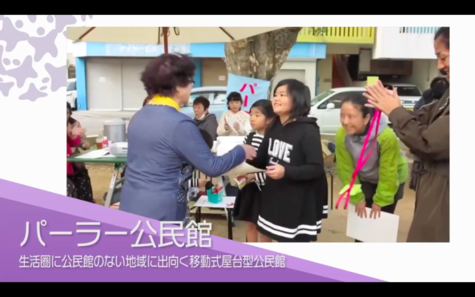
Activity Report ②
Chiiki Support Wakasa (Okinawa) Jun Miyagi, Executive Director
Located along Naha City's western coastline, Chiiki Support Wakasa is dedicated to creating a vibrant and livable community. By creating strong connections between schools, local residents, and families, this NPO, based at the Naha City Wakasa Community Center and Naha City Wakasa Children's Center, is working to transform the area into a dynamic, thriving neighborhood.
★ In this session, we share updates on exciting initiatives like Parlor Community Center and Art Club Activities.
A Dynamic Community Space for Gathering, Learning, and Connecting
Parlor Community Center and Art Club Activities
Centered on the core values of a community center--gathering, learning, and connecting--these initiatives create exciting new opportunities for engagement. Parlor Community Center brings the spirit of community to areas without local centers, while Art Club Activities foster creative collaborations with artists. Chiiki Support Wakasaka is also the driving force behind other efforts to build a more vibrant neighborhood, from disaster-preparedness projects to online information sharing. Guided by the motto "Creating a community where no one is left behind," they provide food support for international students, offer COVID-19 seminars in simple Japanese, and cohost events like the Nepalese New Year Party, all while furthering mutual understanding among people of all ages, nationalities, and genders.
++++++++++++++++++++++++++++++++++++++++++++++++++++++++
【Roundtable Discussion】
Tamura:I'm part of the Wakasa Community Center's LINE group. The center tackles social issues that are quite serious, but they've found creative ways, like using art, to make it easier for foreigners to get involved and build strong connections. It's so important that all of this is happening through the community center. It acts as the heart of a system that encourages local residents to get more involved in society. The work taking place at Wakasa Community Center often comes up in discussions in different fields.
Morishita:I truly believe that community centers, which strike a balance between public and private business, have the power to effect small, incremental changes in society. As the number of people living alone continues to rise, these centers will play an even more crucial role. I have come to realize how important it is to take full advantage of these spaces myself.
Miyagi:At Wakasa Community Center, we are not necessarily focused on producing art, but we instead prioritize community education and local activities, collaborating with artists, experts, and art-based NPOs. I myself used to work at a nearby art NPO, Maejima Art Center. Back in the 1990s, after gang violence made the area unsafe, we turned a rundown bar into an exhibition gallery. It wasn't uncommon to see people passed out in the gallery or kids hanging out in the café late at night because they had nowhere else to go. However, when I began working at Wakasa Community Center, I noticed that people who were truly struggling didn't come to the center. I soon concluded that community centers should strive to be more open and welcoming. So we reached out with the message "You're always welcome here" and created a safe space for those who need that and encouraged connections within the community.
++++++++++++++++++++++++++++++++++++++++++++++++++++++++
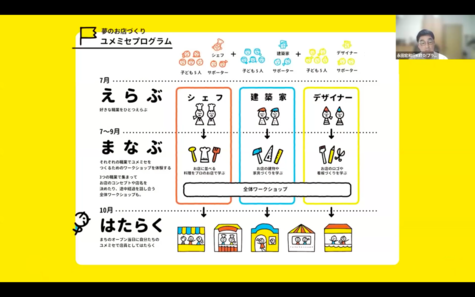
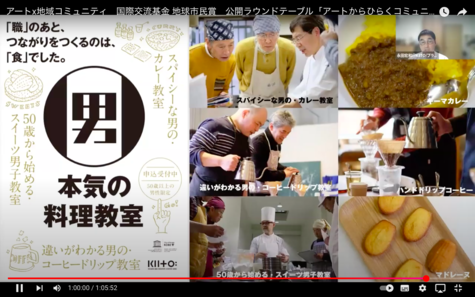
Activity Report③
Plus Arts (Hyogo Prefecture) Hirokazu Nagata, Executive Director
Based in Hyogo Prefecture, Plus Arts is a nonprofit organization that brings creativity and artistic thinking to unrelated fields, including education, community development, disaster prevention, welfare, and international cooperation. Combining social-problem solving and creativity, they are able to come up with innovative solutions for social challenges. One of their standout programs is Learning Disaster Prevention in a Fun Way, a series of engaging workshops held both in Japan and abroad. Nagata also serves as the director of the Design and Creative Center Kobe KIITO, which opened in 2012 in a beautifully renovated former silk-inspection facility on Kobe's Sannomiya waterfront. KIITO is a vital hub in Kobe, which is well known as a city of design--it even encourages its residents to incorporate design into their everyday lives as a way of enhancing their quality of life.
★ In this session, Nagata shares an engaging report on the ventures of the Design and Creative Center Kobe KIITO.
Art Defies Convention: Tackling Social Challenges Through Creative Thinking Design and Creative Center Kobe KIITO
Driven by the belief that art defies convention, KIITO embraces fresh ideas that push the boundaries of conventional thinking to arrive at creative and unusual solutions to social challenges. The center champions the idea that creativity isn't just for a select few--it's a powerful tool accessible to everyone for solving societal issues. KIITO's mission is to make creativity a cornerstone of everyday life, inspiring people of all generations to forge ahead in shaping a new, innovative future. The center proudly introduces a variety of groundbreaking projects that tackle unwieldy social challenges with creativity.
◎Children's Education + Creativity = Chibikkobe:Held every two years since 2012, Chibikkobe is a creative education project in which creators guide children in building and running their own town or business. This innovative program has sparked a positive cycle--participants often advance by attending architecture or culinary schools and then return to volunteer in the project, bringing their skills back to the community.
◎Older Adults + Creativity = Men's Serious Bread-Making Class:A talented chef from Chibikkobe takes retired men under his wing, teaching them new skills and transforming them into vibrant "Bread Maestros," who eventually become active pillars of their community. It doesn't stop there. These men pass on their knowledge by running cafés and shops with kids in a revolutionary town model. Including such exciting roles as Curry Grandpa, Coffee Grandpa, and Madeleine Grandpa, this project has sparked nationwide attention with its dynamic approach to empowering older adults to thrive.
◎Domestic Tourism + Creativity = date KOBE Campaign※:A dynamic project born of the creative ideas of homemakers and designed to cultivate a vibrant dating culture in the heart of Kobe--over thirty companies have joined the effort.
◎Urban Development + Creativity = Bikaeru※:A vibrant project that enlivens the streets with a giant inflatable frog sculpture as well as colorful patterns using the six bold hues of said sculpture. This creative initiative has sparked collaboration among various stakeholders and even led to the creation of a lively market.
◎Intergenerational Connection + Creativity = Fureai Open Café※:In this fresh take on the traditional community café, children take an active role in running a "Children's Café" to address challenges like the care of older adults. This inspiring initiative is spreading across the country.
◎Park + Creativity = Pop-Up Pizza Oven Park Project※: In this exciting project, a temporary pizza oven was set up in a small park, bringing together about a hundred people from the community. The event was so successful that it led to the creation of the Pizza Club, inspiring even those who had never participated in local activities to get involved.
(※These initiatives are part of the "+Creative Seminar," which uses creativity to solve social problems with the motto "Fun answers are better than right answers." Out of forty seminars, about thirty have been successful.)
++++++++++++++++++++++++++++++++++++++++++++++++++++++++
【Roundtable Discussion】
Morishita:The names of these projects are really fantastic. They're fun, catchy, and so inviting--they make you want to join in right away!
Uechi: I tend to forget the seminar's motto, "Fun answers are better than right answers," but it's made me realize just how important that perspective is.
Wakabayashi:When activities are open and shared, the excitement spreads, leading to new approaches and growing communities. I really think this is one of the unique strengths of Plus Arts.
++++++++++++++++++++++++++++++++++++++++++++++++++++++++
Session 2 *Full session video available here ⟩⟩⟩
Art × Disaster Preparedness
///////////////////////////
Jun Miyagi (Chiiki Support Wakasa)[LC][DP][ED]
Yuka Aoki (Alece Takaoka) Toyama [2022] [DP][MC][ED]
Hirokazu Nagata (Plus Arts) Hyogo [2014][LC][DP]
Rika Uechi (Okinawa Arts Council) [LC][DP]
++++++++++++++++++++++++++++++++++++++++++++++++++++++++
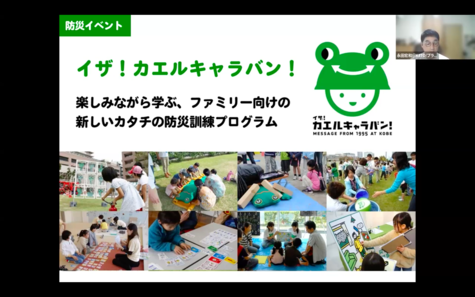
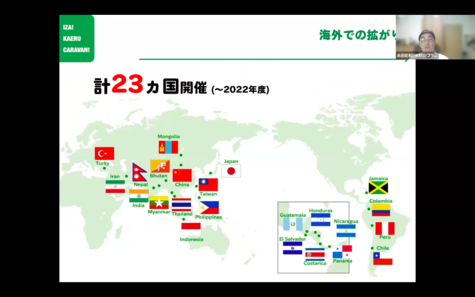
Activity Report④
Plus Arts (Hyogo Prefecture) Executive Director Hirokazu Nagata
In its mission to enrich communities, Plus Arts thinks of a community's constituents as wind, water, earth, and seeds, as it tackles pressing social issues, such as the aging population, creative stagnation, and the low participation in local disaster-preparedness drills. Their current view is that the "seeds" (community events and activities) are being planted in the "earth" (community), which is dry, so they struggle to sprout and grow. Those working to nurture the seeds are facing difficulties, and communities are on the verge of collapse. In this context, Plus Arts envisions itself as the "wind" that carries the seeds; the local community groups as the "water"; the residents who support these groups as the "earth"; and the activities and events as the "seeds." The goal of Plus Arts is to transform and strengthen the seeds, ultimately revolutionizing the approach to disaster-preparedness training.
★ This session shares updates on activities such as the Iza! Kaeru Caravan! and more.
Imperfect Planning + Creativity = Transforming Activities into Irresistible Experiences
Iza! Kaeru Caravan!
This innovative program uses characters, card and board games, and quizzes to transform disaster preparedness into an exciting and engaging experience. With activities like the Fire Extinguisher Ball Toss and Blanket Stretcher Time Trial, it gathers real stories from disaster victims and challenges conventional thinking to create fresh, powerful solutions. Just like in the Art × Community session, the project thrives on the Plus Creative mindset, bringing together designers, artists, NPOs, volunteers, children, and students to create the experience. Originally launched in Kobe, this project has expanded nationwide, with diverse stakeholders coming together to create a collaborative disaster-preparedness festival in communities across Japan. The program has evolved and been adapted for each region, with 631 events held across the thirty-seven prefectures. In the process, rejuvenating older adults, engaging local high school students, and creating a new generation of community leaders, as they break free of the restrictions of aging and stagnation. With its bold vision, "spreading the fun of disaster preparedness worldwide," the program has expanded to twenty-three countries (as of 2022). Each country has localized the program's mascot, giving each project its own unique twist. In Nepal, disaster-preparedness education clubs have been established in elementary schools in five model cities. As of 2024, the program is engaged with new international cooperation efforts in Nepal, India, Makati (Philippines), and Quezon (Philippines), as the project continues to partner with local governments to further strengthen disaster-preparedness initiatives.
++++++++++++++++++++++++++++++++++++++++++++++++++++++++
【Roundtable Discussion】
Aoki: I've been a bit unaware of how to effectively involve people. At Alece Takaoka, where we support children from foreign countries, disaster-preparedness education is a real challenge. When the Noto Peninsula earthquake hit in January 2024, parts of Toyama Prefecture were severely affected. Many foreign residents, especially those facing financial and family difficulties, weren't participating in local disaster-preparedness activities. Because daily life is already difficult for them, they understandably want to forget their troubles on their rare days off - not spend them attending serious disaster drills that force them to imagine worst-case scenarios. Ironically, it was often the very apartment buildings where these residents were likely to live that ended up being some of the ones where people were forced to move out. After hearing about Plus Arts' Iza! Kaeru Caravan!, I realized how important it is to make disaster preparedness fun and to engage these residents in the process.
Uechi: You previously mentioned the importance of "tinkering with the method," and I really like that you allow for flexibility, rather than stick to a fixed method, which makes it easier for communities to adopt the approach that suits them. In Okinawa, with its increasing variety of natural disasters, disaster preparedness is becoming more important. At the Okinawa Arts Council, we're eager to use creativity and art to help people prepare--like doing a warm-up for what's to come.
Wakabayashi: It's clear that using art in preparing for a disaster makes it a kind of rehearsal for when a crisis hits. Mr. Nagata, I imagine your work was deeply influenced by the 1995 Great Hanshin Earthquake. Given the increasing frequency of disasters, do you have any advice on how to better prepare for communication in advance?
Nagata:As disasters become more frequent, many people in local communities are facing isolation during a crisis. With the COVID-19 situation still uncertain, preparing for home evacuation has never been more urgent. We're at a critical point where immediate action is needed. It's crucial to have organizations that can connect and support. Disaster preparedness has shifted from being someone else's concern to being one's own concern, but now the challenge is to get more people involved and make sure everyone understands its importance. We need to push forward and accelerate our efforts.
++++++++++++++++++++++++++++++++++++++++++++++++++++++++
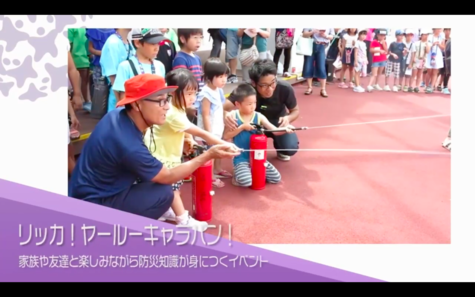
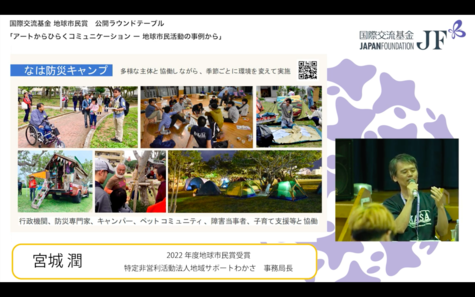
++++++++++++++++++++++++++++++++++++++++++++++++++++++++
Activity Report⑤
Chiiki Support Wakasa (Okinawa) Jun Miyagi, Executive Director
While Okinawa is often considered to be free of earthquakes and tsunamis, history shows otherwise--consider, for example, the famous Meiwa Tsunami. It's clear that the region is not completely immune to these natural disasters, and experts say there's a 26 percent or higher chance of a magnitude 6.0 or stronger earthquake within the next thirty years. The Wakasa Community Center, located just two meters above sea level, served as an evacuation site during the 2024 earthquake off the coast of Taiwan. Many local residents are concerned about what to do in an emergency. With only 33.1 percent of Okinawa residents (and even less in Naha) participating in self-help and mutual-aid disaster groups (compared to 84.3 percent nationwide), there's a clear need for improvement. Drawing on the lessons from the 1995 Great Hanshin Earthquake, which highlighted the importance of self-help and community support, the focus now is on how to tackle each phase of a disaster. The critical seventy-two-hour period for saving lives is central to the center's disaster response strategy.
★This session includes reports on the Rikka! Yaaru Caravan, Naha Disaster Prevention Camp, and the Naha Citizens' Collaborative Graduate Program courses.
A Disaster-Preparedness Camp Centered on Group- Rather Than Self-Responsibility, Where People from All Walks of Life Come Together
Rikka! Yaaru Caravan, Naha Disaster Prevention Camp, and Naha Citizens' Collaborative Graduate Program
◎Rikka! Yaaru Caravan!:We tried a variety of approaches, like creating disaster-preparedness organizations, running tabletop exercises for building networks, and developing disaster-preparedness storytelling based on local traditions. However, things weren't expanding as we had hoped. That's when we realized we needed a disaster-preparedness initiative that would engage people of all ages and backgrounds. Then, I reconnected with Mr. Nagata from Plus Arts, whom I'd known for some time. After learning about the national success of Iza! Kaeru Caravan!, I was inspired to create an Okinawan version. We began developing unique local characters and ideas, and that's how Rikka! Yaaru Caravan! was born.
◎Naha Disaster-Prevention Camp:This unique event, inspired by conversations with a university consortium coordinator who was intrigued by Rikka! Yaaru Caravan!, combines camping with disaster preparedness in a fun, interactive way. It offers participants a chance to experience a simulated evacuation shelter, held at different indoor and outdoor locations throughout the year. Instead of focusing on personal responsibility, the theme is self-sufficiency. Participants are not given a list of required items but are instead asked to prepare for an overnight evacuation, figuring out themselves what to bring. The goal is to share whatever they have and help each other. As the camp has grown, more people have joined, including camping experts and pet owners. The camp is designed for everyone--older adults, children, people with disabilities, and immigrants--empowering them to act in a real emergency. In addition to the camp, there are lectures, symposiums, and theater workshops. For example, a theater workshop with the TSJ Theater Group covered how to handle children with medical needs in evacuation shelters, with participants acting out different roles in improvisations. These emotional, real-world experiences have a much deeper impact than just theoretical knowledge. The project has expanded, collaborating with Naha's Comprehensive Disaster Management Drill, and has even gained interest from areas outside of Naha, leading to the formation of the Disaster Management Platform Okinawa. This has now evolved into efforts to improve evacuation procedures mindful of experiences garnered during the COVID-19 pandemic.
◎Naha Citizens' Collaboration Graduate Program:This initiative focuses on raising disaster awareness among Nepalese students in Okinawa, tackling food shortages in evacuation shelters, and fostering a strong local community through activities like breakfast meetups (led by international students in 2023). These efforts have paid off--when a tsunami warning was issued on April 3, 2024, the staff at Wakasa Community Center acted quickly and smoothly in a seamless response.
++++++++++++++++++++++++++++++++++++++++++++++++++++++++
【Roundtable Discussion】
Aoki:I never realized that combining theater with disaster prevention could be such a powerful approach. It really sparks creativity. To me, using one's imagination is key, because in disaster prevention, that can literally save lives. It's not just about rehearsing in your mind--it's about bringing it to life physically and emotionally. I can tell it's not an easy task, though. If you have any insights or tips, I'd love to hear them.
Miyagi: I think the key is to get the word out. The idea for disaster-preparedness theater actually came from a theater group looking for local partners to explore education through improvisation. Our disaster-preparedness camp might not have been as engaging if we had done it alone. It all started when a camping expert learned about Iza! Kaeru Caravan! and thought that the Wakasa Community Center might be the perfect place to try something new. We tested a small version, saw its potential as a full-fledged program, and ran with it. By sharing our ideas, we sparked interest beyond our local community, and that's what really set things in motion.
Wakabayashi:So the key is to keep sharing your message. Some might think that putting their ideas and expertise out there means losing something valuable, but in reality, it often brings unexpected rewards--like the latest information and new perspectives. Mr. Tamura, what's your take on this?
Tamura: I've been actively involved in the Noto Peninsula earthquake recovery, and the reality remains tough--Wajima City alone still has four hundred people living in evacuate shelters. There's a stark contrast between the idea of disaster preparedness as something fun and engaging and the harsh reality of post-disaster life, and that reality has been weighing on me for years. Unfortunately, not many people are coming to help, and with an aging population, we need to find ways to engage younger generations, like high school students, and foreign residents. The key challenge is how to create that momentum. We know that Art × Disaster Preparedness can be an exciting gateway, but how do we connect that to the actual difficulties on the ground? That's something I'd really like to explore further this afternoon.
++++++++++++++++++++++++++++++++++++++++++++++++++++++++
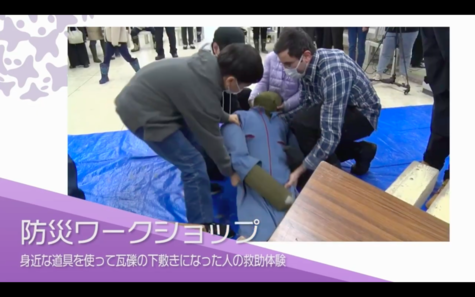
Activity Report⑥
Alece Takaoka (Toyama Prefecture) Yuka Aoki, Chairperson
Since the 1990s, Takaoka City has been home to a growing community of foreign workers. However, foreign children were struggling in school and missing out on higher education, and this became the unchallenged norm. This unfair reality wasn't even up for debate--it was simply accepted. Determined to change that, in 2010 we established Alece Takaoka, a learning-support program providing these children with the opportunities they deserved. From 2020, we have developed educational programs for building a truly inclusive community--one in which people of all backgrounds understand and respect each other, embracing their differences.
★ In this session, we shared updates on initiatives like the Disaster Preparedness Workshop and more.
Harnessing Diversity for a Stronger Community
Disaster Preparedness Workshop
With the theme "Turning diversity into strength," we organized a Disaster Preparedness Workshop in partnership with the local fire department. Families, including those from abroad, joined in a hands-on rescue exercise, learning how to use everyday objects to help someone trapped under debris. Beyond disaster readiness, this workshop aimed to forge deeper connections and mutual understanding. By working together in a crisis scenario, participants experienced firsthand the power of community--embracing diversity as a strength that brings people closer and makes us all more resilient.
++++++++++++++++++++++++++++++++++++++++++++++++++++++++
【Roundtable Discussion】
Wakabayashi:You've been working to support the education of young people with foreign backgrounds. What motivated you to get involved in disaster preparedness, which is such a unique and urgent concern?
Aoki:Our main focus is on education, with an emphasis on involving young people and helping them understand the importance of participating and working in the community. One of our staff members happens to be in the local fire brigade, which led us to offer disaster-preparedness workshops. In a community where people live side by side but rarely interact, there was a growing frustration over the lack of connection. It may seem odd, but disaster preparedness is, in a way, relevant to these issues too. Disasters force us all to face each other, which is why we approach it with the goal of encouraging everyone to use their imagination and think about how we should act when disaster strikes.
Uechi:I lived in Toyama for a while and was involved in art projects, including hosting international artists through an artist residency. I remember seeing how even small earthquakes would throw foreign guests into confusion, which really highlighted for me how important it is to engage with foreign children in Toyama on a daily basis. The idea of simply sharing the same space, makes me wonder how exactly to address that challenge.
Wakabayashi:In light of the Alece Takaoka example and Mr. Tamura's question about how we balance the fun side of disaster preparedness with the tough realities, could you please share your final thoughts, Mr. Nagata.
Nagata: I've had the same concerns as Mr. Tamura for a long time. Since 2005, I've been involved in supporting different communities and have noticed a deep-rooted problem: the weakening of community connections. This is becoming apparent now in Noto. Disaster preparedness could be our last line of defense. There is more and more evidence that even when community ties are weak, disaster preparedness can serve as a powerful catalyst to bring people together. I completely agree with Ms. Aoki's point about how to use disasters and disaster preparedness. It's absolutely the right approach. Instead of saying that disaster preparedness is fun, it might be better to say that disaster-preparedness education is fun. Although we face challenges like creative stagnation and an aging population causing the breakdown of communities, there's still plenty of potential for community regeneration, as seen in examples like the Bread Grandpas and the Pizza Club. Through ongoing efforts like these, we need to keep asking ourselves: how can we build a richer, stronger community and society? The answer lies in continually exploring different ways to make it happen.
Wakabayashi:Disaster preparedness is like planting a seed--it's about sparking action and keeping it going. From what we've discussed, it's clear that ongoing communication is key in confronting the tough challenges ahead.
Keywords
Back Issues
- 2025.9.30 The 51st Japan Found…
- 2025.9.30 The Japan Foundation…
- 2025.9.30 Bringing the World C…
- 2025.9.30 The 51st (2024) Japa…
- 2025.9.30 Japan Foundation Pri…
- 2025.9.30 Japan Foundation Pri…
- 2024.5.24 The 50th Japan Found…
- 2024.3. 4 Movie Theaters aroun…
- 2023.4.10 The 49th Japan Found…
- 2023.3.28 JF's Initiatives for…

